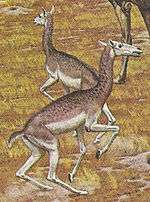Procamelus
| Procamelus Temporal range: middle to late Miocene | |
|---|---|
| | |
| Mummified Procamelus head. | |
| Scientific classification | |
| Kingdom: | Animalia |
| Phylum: | Chordata |
| Clade: | Synapsida |
| Class: | Mammalia |
| Order: | Artiodactyla |
| Family: | Camelidae |
| Tribe: | Camelini |
| Genus: | †Procamelus Leidy, 1858 |
| Species | |
| |
Procamelus is an extinct genus of terrestrial herbivore the family Camelidae, endemic to North America from the Oligocene through Miocene 20.6—4.9 mya, existing for approximately 15.7 million years.[1]
Taxonomy

Priscocamelus was named by Leidy (1858). It is not extant. It was assigned to Camelidae by Leidy (1858) and Carroll (1988).[2] The name is derived from the Greek πρό, meaning "before", and κάμελος (camel), thus "early camel."
Morphology
It had long legs designed for speed, and was about 1.3 metres (4.3 ft) in height at the shoulder, slightly smaller than a modern llama. Unlike modern camelids, it had a pair of small incisor teeth in the upper jaw. The remaining teeth were large and adapted for eating tough vegetation. The shape of the toes suggests that it possessed foot pads, like modern camels, but unlike earlier forms of camelid, which generally had hooves. This would have helped it walk over relatively soft ground.[3]
Body mass
A single specimen was examined for estimated body mass by M. Mendoza, C. M. Janis, and P. Palmqvist. This specimen was estimated to weigh 53.3 kg (120 lb).[4] It had a straighter neck than Oxydactylus or Aepycamelus.
References
- ↑ PaleoBiology Database: Procamelus, basic info
- ↑ R. L. Carroll. 1988. Vertebrate Paleontology and Evolution. W. H. Freeman and Company, New York 1-698
- ↑ Palmer, D., ed. (1999). The Marshall Illustrated Encyclopedia of Dinosaurs and Prehistoric Animals. London: Marshall Editions. p. 275. ISBN 1-84028-152-9.
- ↑ M. Mendoza, C. M. Janis, and P. Palmqvist. 2006. Estimating the body mass of extinct ungulates: a study on the use of multiple regression. Journal of Zoology 270(1):90-101
| Wikimedia Commons has media related to Procamelus. |